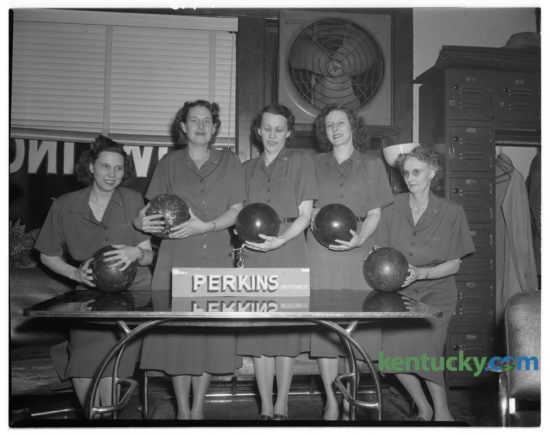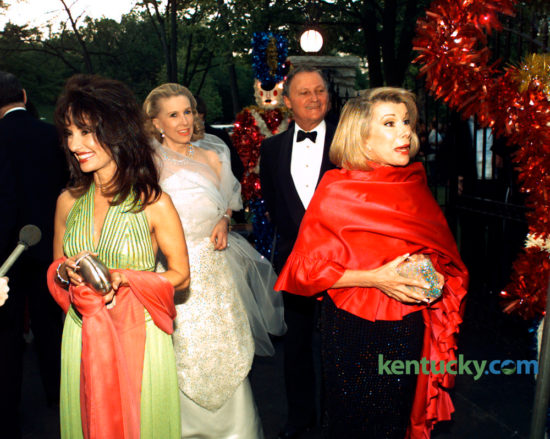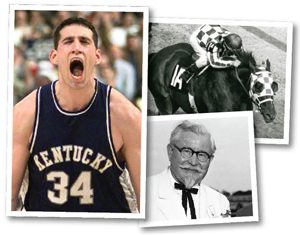October 31, 2025
Kentucky River bridge construction, 1992
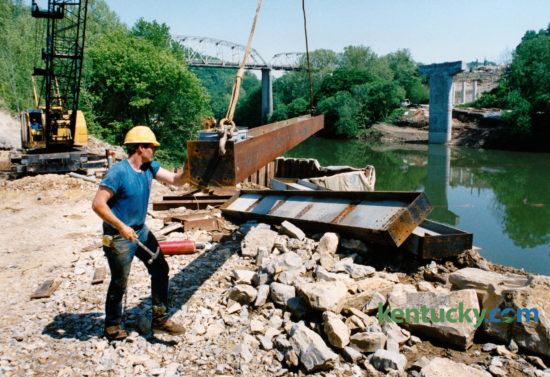
Doug Felton with Kay & Kay Contracting helped guide a steel beam to be used to support a pier on a new bridge being built across the Kentucky River at Boonesboro on May 11, 1992. The Ky. 627 bridge connects Clark and Madison counties and replaced the old bridge, visible in the background. In 2002, the bridge was renamed the Ewart W. Johnson Bridge. Johnson was the Kentucky State Parks commissioner from 1971 to 1975, and he was instrumental in the construction of Ky. 627 from Winchester to Boonesboro. The old road had been the scene of a rash of fatalities, and Johnson advocated for a safer route. Photo by Charles Bertram | Staff
Women’s bowling league winners, 1948
Mime class at Julia R. Ewan Elementary, 1986
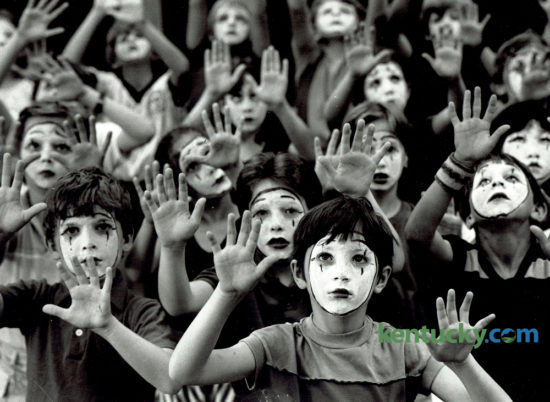
Third- and fourth-graders at Julia R. Ewan Elementary School in Lexington performed a mime routine on May 9, 1986, pretending that they had come up against a wall. The students, in a program for gifted and talented children, had participated in a weeklong workshop on mime. Photo by Ron Garrison | Staff
The Versailles castle under construction, 1972
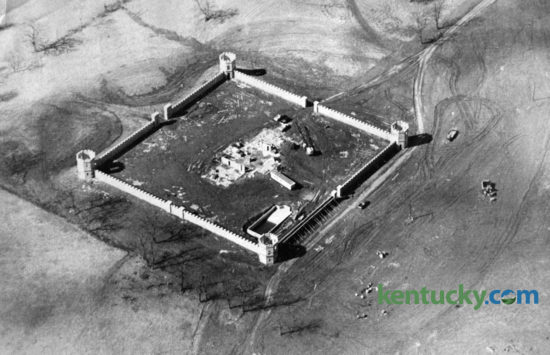
The castle in Woodford County, under construction in 1972. Sitting on 50 acres on U.S. 60 east of Versailles near the Fayette County line, it has been a Central Kentucky curiosity for more than 45 years. Lexington contractor Rex Martin Sr. started building the castle in 1969, but it sat unfinished and empty for decades. At the time of this picture, the inner building was under construction, the foundation for the pool had been poured, and the four turrets had yet to be roofed. Tom Post, a graduate of Lexington’s Lafayette High School and the University of Kentucky, bought it for $1.8 million in 2003. While it was being restored, a fire in May 2004 burned the house. Post rebuilt it, and in 2008, he opened it as CastlePost, a tourist inn and luxury bed-and-breakfast in the heart of Bluegrass horse country. In 2010, it was put on the market with an asking price of $30 million. It was revealed this past week that a potential buyer has come forward. The Lexington-Bluegrass Association of Realtors website indicates a “sale pending” for the $15 million listing. Click on the image for a closer look. Herald-Leader File Photo
UK College of Arts and Sciences graduation, 1991
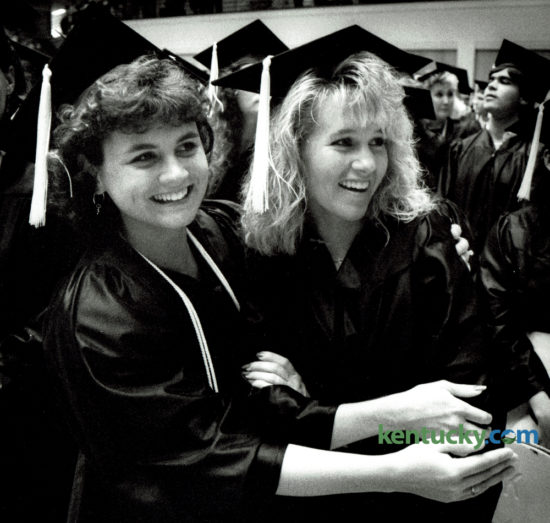
Betsy Johnson, left, of Youngstown, Ohio, and Michelle Thompson ofLexington, posed for photos before the University of Kentucky commencement ceremony on May 5, 1991. Both graduated with degrees from the College of Arts and Sciences. UK held graduation exercises this weekend, starting Friday and ending Sunday with the College of Arts and Sciences, the College of Social Work and the College of Design at 10 a.m., and the College of Education, the College of Engineering and the College of Medicine at 2 p.m., all in Rupp Arena. Photo by Charles Bertram | Staff
Jockey Pat Day wins Kentucky Derby, 1992
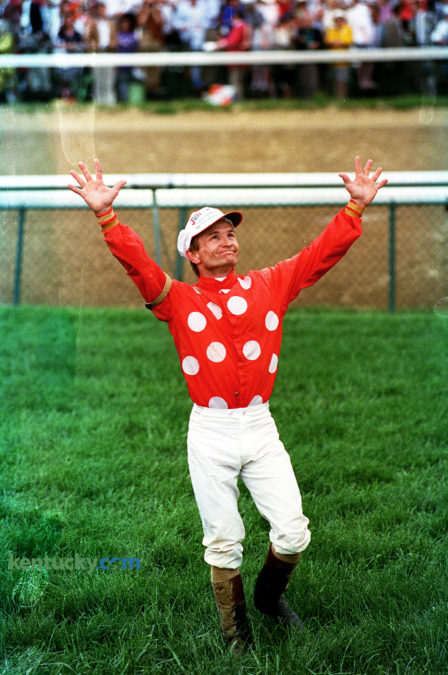
Jockey Pat day celebrated his first — and only — Kentucky Derby win on May 2, 1992, at Churchill Downs. Day rode Lil E. Tee to an upset of 4-5 favorite Arazi, who was hailed as the second coming of Secretariat. Arazi finished eighth, the worst finish in Derby history by a favorite who was odds-on or less. Lil E. Tee was a star only in the barn of his owner, W. Cal Partee of Magnolia, Ark., and trainer Lynn Whiting of Louisville. In the week leading up to the race, he wasn’t even stabled in the Derby barns. Instead, he was kept with the rest of Whiting’s horses in an area well removed from the commotion that saw hundreds of people follow Arazi to the track each day. Day and Whiting weren’t reluctant to say during the week that they liked their colt’s chances. But so few people paid attention, while caught up in Arazi’s spell, that Lil E. Tee went to the post as the sixth betting choice. Day, a crowd favorite, is the all-time leading rider at both Churchill Downs and Keeneland. During his 32-year career, he won 21.3 percent of his races. He retired in 2005 with career earnings of $297,912,019, second all time. Photo by Ron Garrison | Staff
Ex-presidents Ford, Carter at the Kentucky Derby, 1983
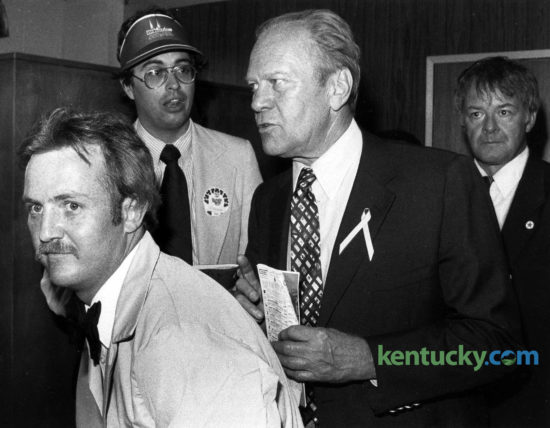
Former President Gerald Ford at the Kentucky Derby on May 7, 1983. On the sixth-floor Skye Terrace, he looked tanned and relaxed in a navy blue blazer. When asked about his Derby pick, the former president said his “sentimental and otherwise favorite is Country Pine,” who was owned by the son of his host, Darby Dan Farm owner John Galbreath. The 38th president, serving from 1974 to 1977, attended 13 Kentucky Derbys, more than any other president. Photo by Paul Lambert. Herald-Leader Archive Photo
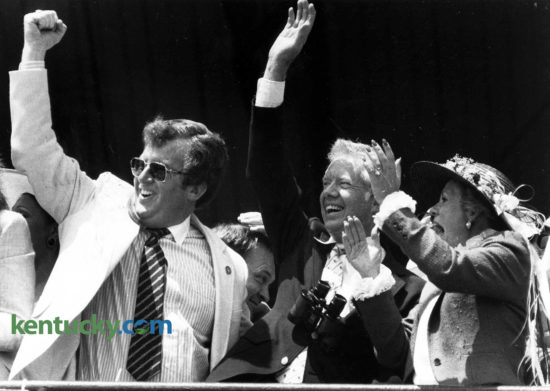
Former President Jimmy Carter cheered during Derby Day on May 7, 1983. Flanking him were breeder Tom Gentry and his wife, Kathy. It was Carter’s first and only visit to the Derby. Carter, who looked like a pro, surveying the track with his binoculars from the sixth-floor Skye Terrace, started his day by jogging at Gentry’s Lexington farm. He later helped saddle one of Gentry’s horses for the fourth race. The horse won. Carter was the 39th president, serving from 1977 to 1981. Ford and Carter weren’t the only high-profile politicians in attendance. Vice President George H.W. Bush also was there, a guest of Versailles horseman Will Farish, a longtime friend and hunting buddy. It was Bush’s first of four visits to the Derby. Former Secretary of State Henry Kissinger also attended. He was spotted in a third-floor box signing an autograph on a $100 bill. Photo by Gary Landers | Staff
President Richard Nixon at the Kentucky Derby, 1969
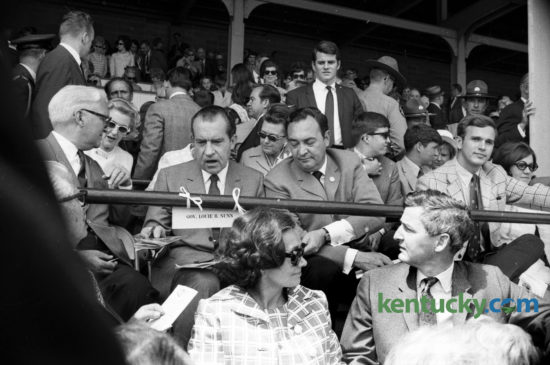
President Richard Nixon was a guest in the finish-line box of Kentucky Gov. Louie Nunn, at right of Nixon, in Nunn’s Churchill Downs finish-line box on Kentucky Derby Day, May 3, 1969. Nixon was the first — and only — sitting president to attend theDerby. He did pick the winner of the 95th Run for the Roses, Majestic Prince, who hailed from Nixon’s native California. “He won! He won!” the 37th U.S. president shouted to Louella Dirksen, wife of Senate Minority Leader Everett Dirksen, as Majestic Prince crossed the finish line. The president and his wife, Pat, did not, so far as could be determined, bet on the race. Nixon was asked during the day whether he planned to sample a mint julep. “I’m going to savor this race Kentucky style,” was his diplomatic answer. Nixon attended the Derby as part of a campaign pledge to Nunn, who was hosting 24 other governors in connection with the Republican Spring Governor’s Conference that week in Lexington. Also attending that day was then-California Gov. Ronald Reagan, the future president, and his wife, Nancy Reagan. Within 35 minutes of the end of the race, Nixon was aboard Air Force One, flying back to Washington. Herald-Leader Archive Photo
Dancer’s Image, the only Kentucky Derby winner to be disqualified, 1968
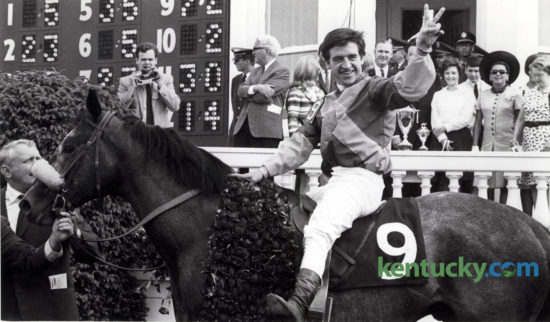
Jockey Bobby Ussery flashes the victory sign on May 4, 1968, atop Dancer’s Image in the winner’s circle of the 94th Kentucky Derby at Churchill Downs in Louisville. Dancer’s Image was later disqualified and was placed last because of a positive drug test after the race. He is the only Derby winner to have been disqualified in the 143-year history of the race. Traces of phenylbutazone, known as bute, were found in Dancer’s Image’s post-race urinalysis. It was legal at some tracks at the time, but Churchill Downs wasn’t one of them. Today, the anti-inflammatory is one of the most commonly used drugs in horse racing, given to alleviate chronic pain and joint inflammation and not to enhance performance. Kentucky medication rules allow any of the 20 horses running in Saturday’s Derby to be given bute more than 24 hours before the race, provided their post-race sample doesn’t exceed a specified amount. Calumet’s Forward Pass became the winner of the 94th Kentucky Derby. Herald-Leader Archive Photo

